Open Access Library Journal
2018, Volume 5, e4267
ISSN Online: 2333-9721
ISSN Print: 2333-9705
Design of Drive System for Sensorless
Brushless DC Motor Based on Model Reference
Adaptive Control and Its Application in
Horizontal Well Tractor
Zhou He, Yongjun Chen*, Bo Ruan, Shuhan Yu, Junwen Zhou
College of Electronics and Information, Yangtze University, Jingzhou, China
How to cite this paper: He, Z., Chen, Y.J.,
Ruan, B., Yu, S.H. and Zhou, J.W. (2018)
Design of Drive System for Sensorless
Brushless DC Motor Based on Model Re-
ference Adaptive Control and Its Appli-
cation in Horizontal Well Tractor. Open
Access Library Journal, 5: e4267.
https://doi.org/10.4236/oalib.1104267
Received: December 18, 2017
Accepted: February 6, 2018
Published: February 9, 2018
Copyright © 2018 by authors and Open
Access Library Inc.
This work is licensed under the Creative
Commons Attribution International
License (CC BY 4.0).
http://creativecommons.org/licenses/by/4.0/
Open Access
Abstract
The actual working environment temperature of the horizontal well tractor is
too high, which leads to position sensor of general brushless DC motor
(BLDCM) cannot work normally. Therefore, the position sensorless drive
system is designed to overcome the problems caused by the position sensor in
the actual working conditions. The principle of sensorless BLDCM work is
introduced in detail, And drive system of Sensorless BLDCM was established
by using simulation software. The use of three stage start make motor smoothly
start, the motor speed detection based on model reference adaptive control
(MRAC), ensures accurate commutation. Finally, the hardware and software
design of the BLDCM system based on digital signal controller (DSC) is in-
troduced and tested. The experimental results show that the drive system can
start the BLDCM smoothly in the high temperature environment, and can
quickly track the given speed, which meet the actual work demand of the ho-
rizontal well tractor.
Subject Areas
Electric Engineering
Keywords
Horizontal Well Tractor, Brushless DC Motor (BLDCM), Position Sensorless,
Model Reference Adaptive Control (MRAC)
1. Introduction
As horizontal well technology is increasingly used in oil and gas development,
DOI: 10.4236/oalib.1104267 Feb. 9, 2018
1
Open Access Library Journal
�
Z. He et al.
horizontal well tractors have been proposed as a new type of downhole motion
device. It can meet the delivery of logging tools and auxiliary work such as per-
foration and fishing to solve the problem that the instrument is difficult to be
transported to a predetermined position in the downhole and horizontal wells by
gravity.
Brushless DC Motor (BLDCM) is a new mechatronic product with many ad-
vantages such as stable structure, high power density, high efficiency, easy main-
tenance, long life and easy driving. It has been widely used in the fields of aero-
space, automotive, robotics, household appliances and medical devices. There-
fore, BLDCM has been chosen as drive motor of horizontal well tractor. The
overall structure of the horizontal well tractor is shown in Figure 1.
However, due to the too high actual working environment temperature of the
horizontal well tractor, the position sensor of general BLDCM cannot work
normally [1] [2] [3] [4]. As a result, the general BLDCM will generate wrong
commutation signals in this working environment, which may cause the motor
lost step or even block turn. Therefore, the BLDCM used as drive motor of hori-
zontal well tractor needs to adopt a positionless driving manner to overcome the
problem caused by the position sensor in the actual working condition.
Based on the analysis principle of sensorless BLDCM work, the simulation of
drive system for sensorless BLDCM was established by using PSIM simulation
software [5] [6]. The use of three stage start make motor smoothly start, the mo-
tor speed detection based on model reference adaptive control (MRAC) [7], en-
sures accurate commutation. Finally, the drive system for sensorless BLDCM was
established based on digital signal controller (DSC) and tested. The experimental
results show that the drive system can make BLDCM run stably in the high tem-
perature environment and meet the actual working conditions of the horizontal
well tractor.
Monitoring
system on well
PC
Main
Control
485 bus
RX
TX
TX
RX
SCM
TX
RX
power line
carrier
communication
power line
carrier
communication
single-core cable
BLDC_DRIVE_1
BLDC_DRIVE_2
BLDC_DRIVE_3
BLDC_DRIVE_4
BLDC_DRIVE_5
Figure 1. The overall structure of the horizontal well tractor.
2
Open Access Library Journal
DOI: 10.4236/oalib.1104267
�
Z. He et al.
2. The Principle of Sensorless BLDCM Work
2.1. The Mathematical Model of BLDCM
BLDCM selected by horizontal well tractor is star connection and the central
node is not led out, its equivalent circuit shown in Figure 2.
According to Kirchhoff’s voltage law, the equation of phase voltage can be ob-
tained as follows:
+
=
L
0
0
0
R
0
R
0
0
V
a
V
b
V
c
i
0
a
i
0
b
R i
c
i
a
i
b
i
c
V V V —Voltage of each phase to the ground;
in type:
a
i —Phase current;
i
,
c
b
k ω=
—Back EMF,
e m
i
,
a
E
0
L
0
0
0
L
d
t
d
,
,
b
c
×
+
E
a
E
b
E
c
+
V
n
V
n
V
n
(1)
x
k ω are back EMF coefficient and rotor mechani-
,e
m
cal speed;
R —Phase resistance;
L L
s
L
m
=
− —Equivalent inductance of stator winding,
L L are self induc-
,s
m
tance of stator winding and mutual inductance between stator winding;
nV —Central node voltage of motor armature winding.
2.2. Principle of Back EMF Zero Crossing Detection
The back EMF of BLDCM is a trapezoidal wave, the current is a square wave,
and the phase current of each phase winding must be consistent with the back
EMF in order for the BLDCM to output the maximum torque. Therefore, Com-
mutation is required for every 60°electric angle in one electric period. Relation of
back EMF and current in BLDCM as shown in Figure 3. It can be seen from
Figure 3 that back EMF zero crossing point leading the current commutation
signal 30˚ in each phase winding, So, The commutation time can be got accord-
ing to the back-EMF zero crossing point. The motor back EMF can not be meas-
ured directly, so, It is necessary to calculate the equivalent voltage by phase vol-
tage.
Set x phase is the non-conducting phase, the phase current is 0, according to
Equation (1) can be got:
(2)
It can be seen from Equation (2) that the commutation signal can be obtained
V V
x
n
E
=
−
x
aV
bV
cV
L
L
L
ai
bi
ci
R
R
R
+
aE
bE
cE
+
+
-
-
nV
Figure 2. Equivalent circuit of a star connection BLDCM.
-
DOI: 10.4236/oalib.1104267
3
Open Access Library Journal
�
aE
ai
30
90
150
210
270
330 360
BEMF zero crossing
point
bE
bi
Current commutation signal
cE
ci
a phase
0
b phase
c phase
Z. He et al.
)
/(°θ
)
/(°θ
)
/(°θ
Figure 3. Relation diagram of back EMF and current.
indirectly by comparing the relationship between the phase voltage and the cen-
tral node voltage.
Since the center node of the motor selected by the drive system is not led out,
it is necessary to fabricate the motor central node voltage.
As a BLDCM, there are only two phases which have current at the same time,
Due to conducting two-phase current equal to the opposite direction, the other a
phase current is 0, from Equation (1) can be got:
E
+
c
(3)
It can be seen from Figure 2 that the sum of the three phase back EMF is zero
when the back-EMF zero crossing, so, the central node voltage at this time can
be got as:
V
3
n
E
a
E
b
+
V
a
+
V V
b
c
+
=
+
V
n
=
V
a
+
+
V V
b
c
3
(4)
3. Simulation and Analysis of Sensorless BLDCM Drive
System Based on PSIM
According to the above analysis, Block diagram of drive system for sensorless
BLDCM shown in Figure 4, the drive system uses speed, current double closed-
loop control.
PSIM is a computer simulation software specially designed for power elec-
tronics and motor control. It provides a powerful simulation environment for the
research of power electronics analysis and digital control motor drive, and uses
4
Open Access Library Journal
DOI: 10.4236/oalib.1104267
�
Z. He et al.
I _
act
DC
source
Spd_
ref
I _
ref
PI
U
PI
PWM
controller
Three phase
inverter
BLDCM
Spd_
act
Commutation
signal
Speed
calculation and
positionless
commutation
Figure 4. Sensorless BLDCM drive system block diagram.
PSIM to establish drive system of sensorless BLDCM according to Figure 3. The
parameters of the motor are as follows: The stator resistance is 11.9 Ω, the stator
inductance is 2.07 mH, the stator mutual inductance is 0.69 mH, the number of
motor pole pairs is 2, the back EMF coefficient is 16.15 V·krpm−1, the moment of
inertia is 0.007 g·m2, the friction coefficient is 1.167 g·m2·s−1, the inverter input
voltage is 300 V, the given speed is 6000 rpm.
3.1. Three Stage Start of Sensorless BLDCM
Since the back EMF increases with the increase of speed, the back EMF zero-
crossing detection is not suitable for motor starting. The drive system adopts
three stage start algorithm when the motor is starting, namely, the rotor
pre-positioning, external synchronous acceleration, self-synchronization. Figure
5 and Figure 6 are diagrams of rotor position using a three stage start algorithm.
From Figure 5 and Figure 6 shows, the use of three stage start algorithm can
be achieved smooth start of the motor. Figure 7 is the motor speed response
curve.
It can be seen from Figure 7, the use of three stage start algorithm to start, the
speed can be in a relatively short period of time to track the given speed to
achieve the desired start effect. Figure 8 is the a phase voltage, PWM and current
after switch to self-synchronizing.
Visible, the simulation results consistent with the previous theoretical analysis,
the back-EMF zero-crossing lead the phase commutation signal 30˚ electrical
angle.
3.2. BLDCM Speed Detection Based on Model
Reference Adaptive Control
Based on the above analysis, Commutation of sensorless BLDCM based on the
back-EMF zero-crossing detection needs to delay 30˚ electric angle time accord-
ing to speed, therefore, the accuracy of speed detection is crucial for commuta-
tion of sensorless BLDCM. The traditional speed detection is calculated by the
time difference between two commutation signals. The obtained speed is the av-
erage speed between two commutation signals, which is not accurate enough, so
commutation can not be performed at the optimum commutation time, So it is
5
Open Access Library Journal
DOI: 10.4236/oalib.1104267
�
Figure 5. Diagrams of rotor position with an initial electric angle of 0 degrees.
Figure 6. Diagrams of rotor position with an initial electric angle of 200 degrees.
Z. He et al.
Figure 7. Motor speed response curve.
DOI: 10.4236/oalib.1104267
6
Open Access Library Journal
�
Z. He et al.
Figure 8. The a phase voltage, PWM and current after switch to self-synchronizing.
necessary to find a more accurate method of speed detection.
For BLDCM, when the current from phase a to phase b is considered. There
are following equations:
i
i
= −
a
b
=
i
0
c
E
= −
a
E
b
(5)
According to the formula (1) the line voltage between phase a and phase b can
be obtained:
V
ab
=
V V
a
b
−
=
2
Ri
a
+
2
L
i
d
a
t
d
+
2
E
a
In stable condition,
i
d
t
d
≈ . Then, (6) can be rewritten as:
0
ω
m
=
V
ab
Ri
a
2
−
k
2
e
(6)
(7)
According to Equation (7), the motor speed can be calculated according to the
line voltage and phase current, but the motor windings resistance could change
with the change of temperature. Therefore, BLDCM speed detection based on
model reference adaptive control (MRAC) is proposed. As shown in Figure 9.
As can be seen from Figure 9, the main module of speed detection is a model
reference adaptive regulator,
Spe est is speed estimated by line voltage and
phase current,
Spe ce is speed calculated by the commutation signal, The in-
put of regulator is the deviation of the two speed, the output of the regulator is a
correction variable quantity
ck to estimate the speed.
_
_
DOI: 10.4236/oalib.1104267
When the motor stator winding resistance increases from 11.9 Ω to 15.9 Ω, the
actual motor speed, the speed calculated based on the fixed resistor value, the
7
Open Access Library Journal
�
Z. He et al.
ck
abV
ai
=ω
m
V
ab
Ri
a
c
k
2−
k
2
e
Spd_
est
PI
Spd _
ce
Figure 9. BLDCM speed detection based on model reference adaptive.
Figure 10. Comparison of several speed detection methods.
speed detected based on the commutation signal and the estimated speed based
on the MRAC are shown in Figure 10.
It can be seen from Figure 10 that after the change of the resistance of the sta-
tor winding of the motor, the estimated speed based on the MRAC is the closest
to the actual speed.
4. Actual Test and Result Analysis of Drive System
for Sensorless BLDCM
4.1. DSC Based Drive System of Sensorless BLDCM
Drive system of sensorless BLDCM includes two parts: software and hardware,
the software part includes the main program and several subroutines and inter-
rupt service functions, the main function is to achieve BLDCM without position
start, commutation, PWM duty cycle setting and communicate with the upper
computer. The hardware part includes the controller, drive circuit, three phase
inverter, voltage and current sampling circuit. and the overall structure of the
drive system is shown in Figure 11.
As the actual working environment temperature of the horizontal well tractor
is too high, there are high requirements on the controller. Therefore, the control-
ler of the drive system adopts the dsPIC series chip of the MICROCHIP company.
8
Open Access Library Journal
DOI: 10.4236/oalib.1104267
�

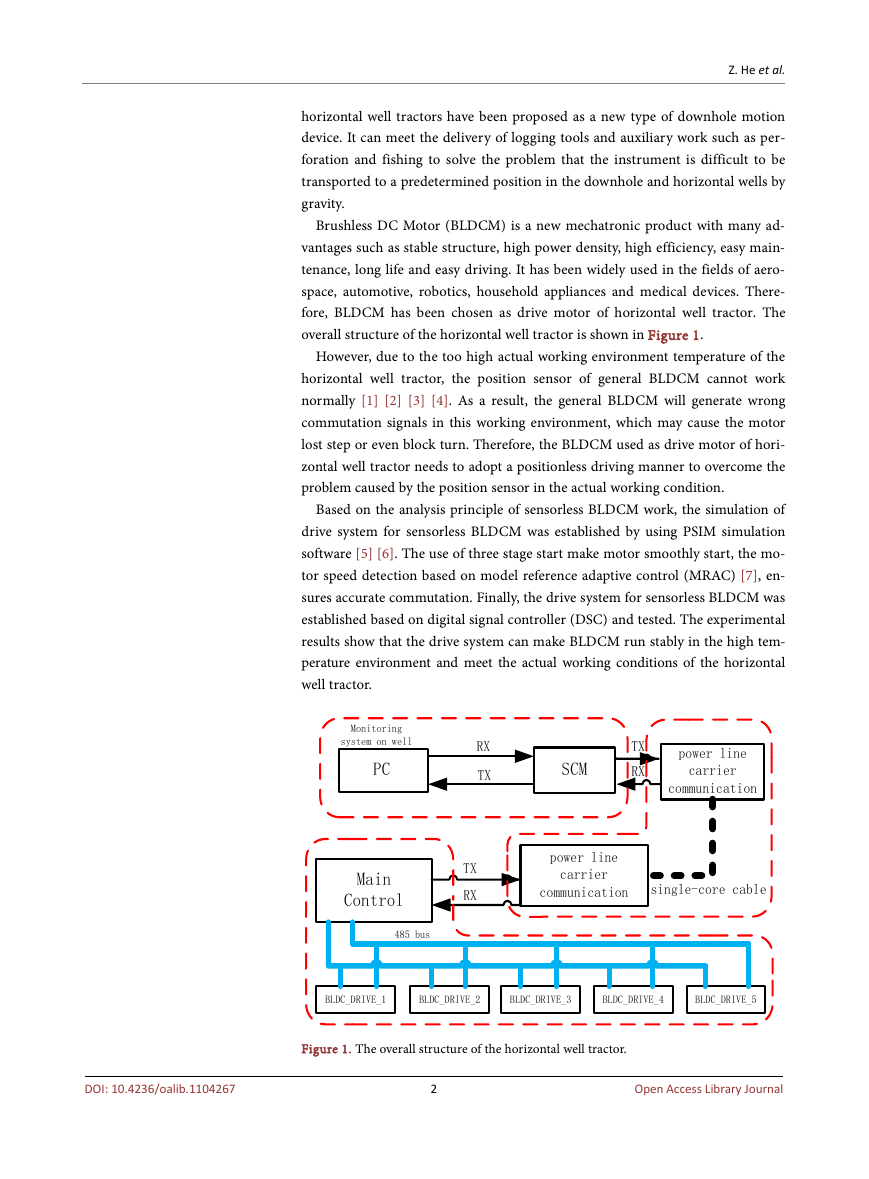
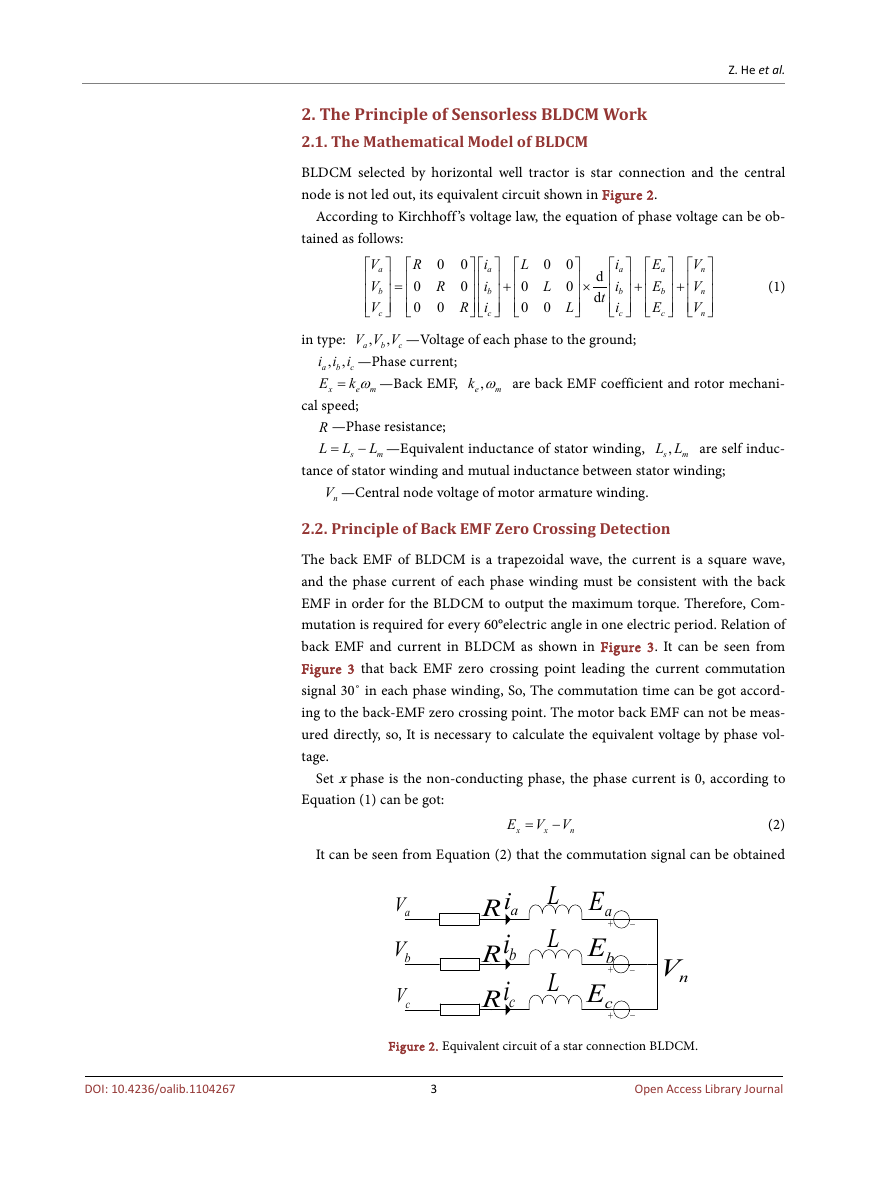
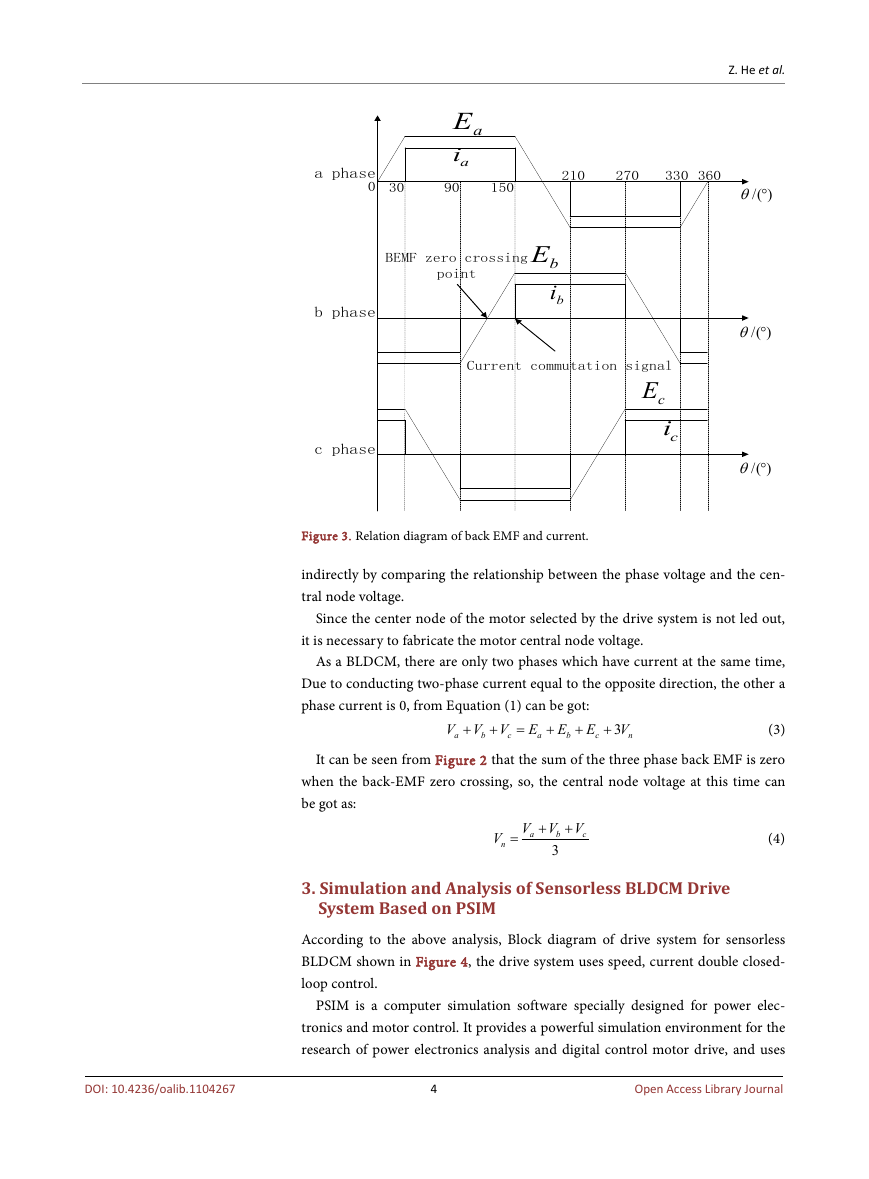
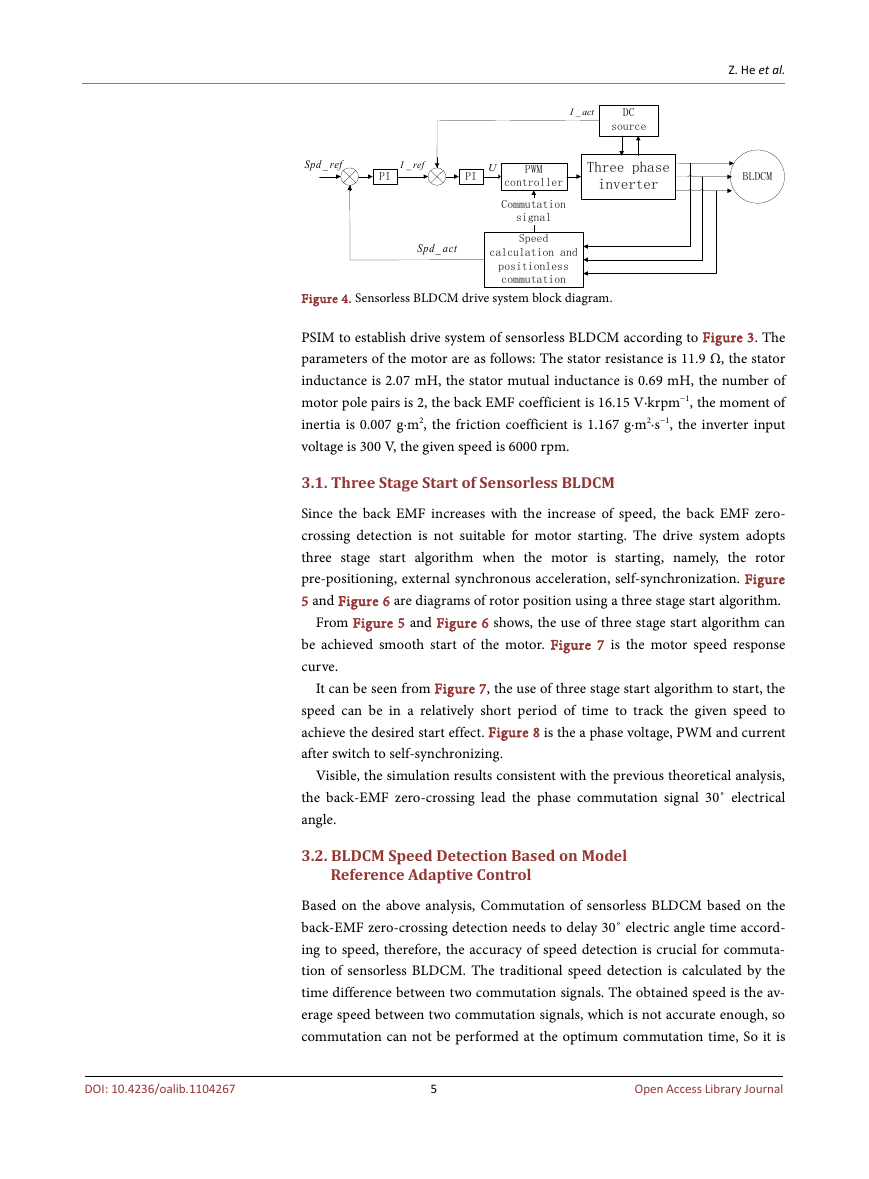
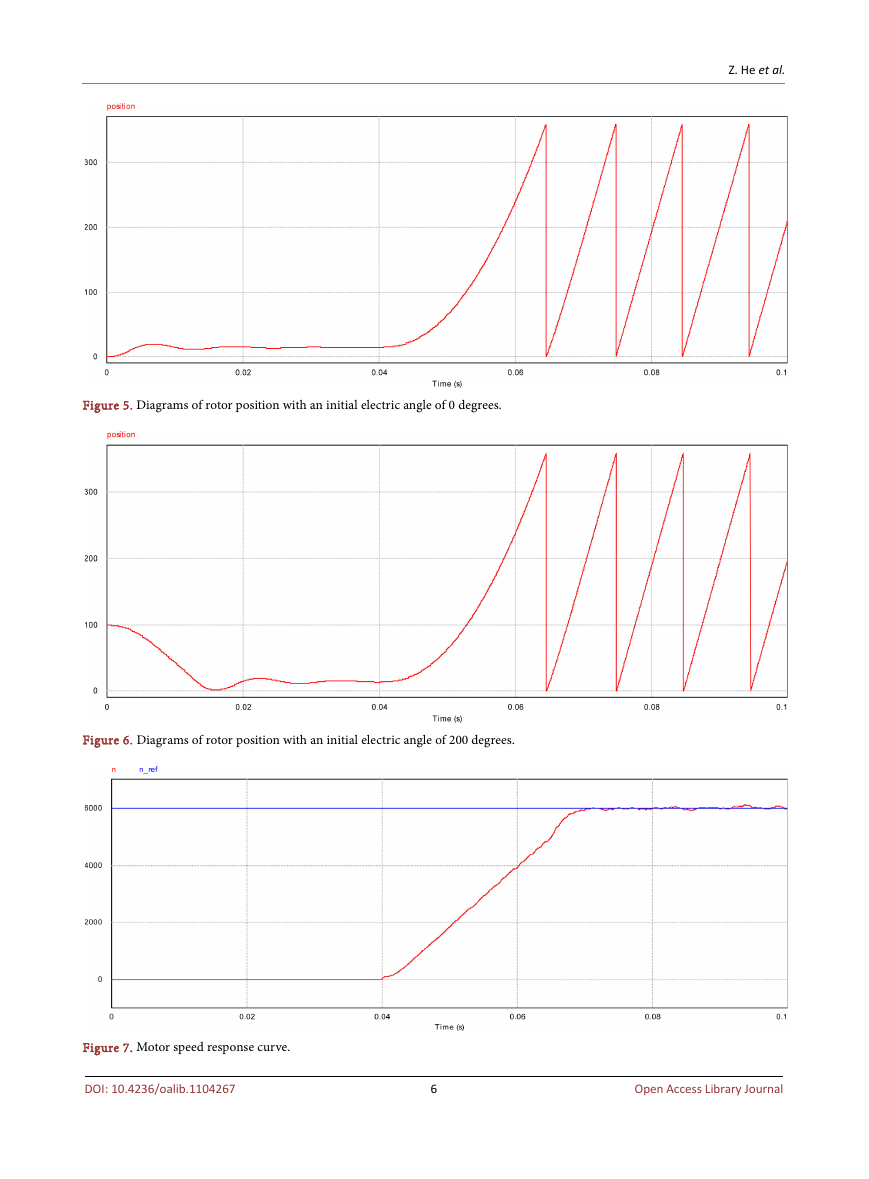
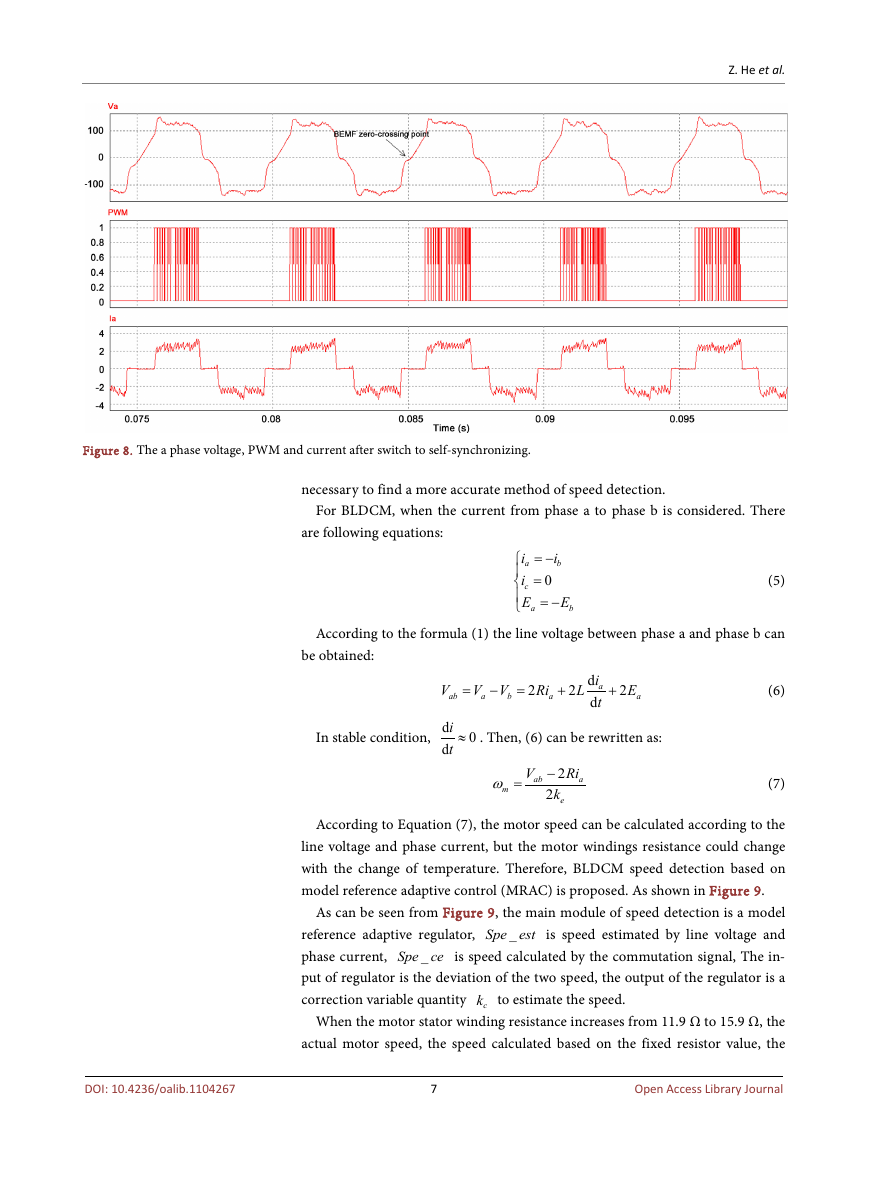
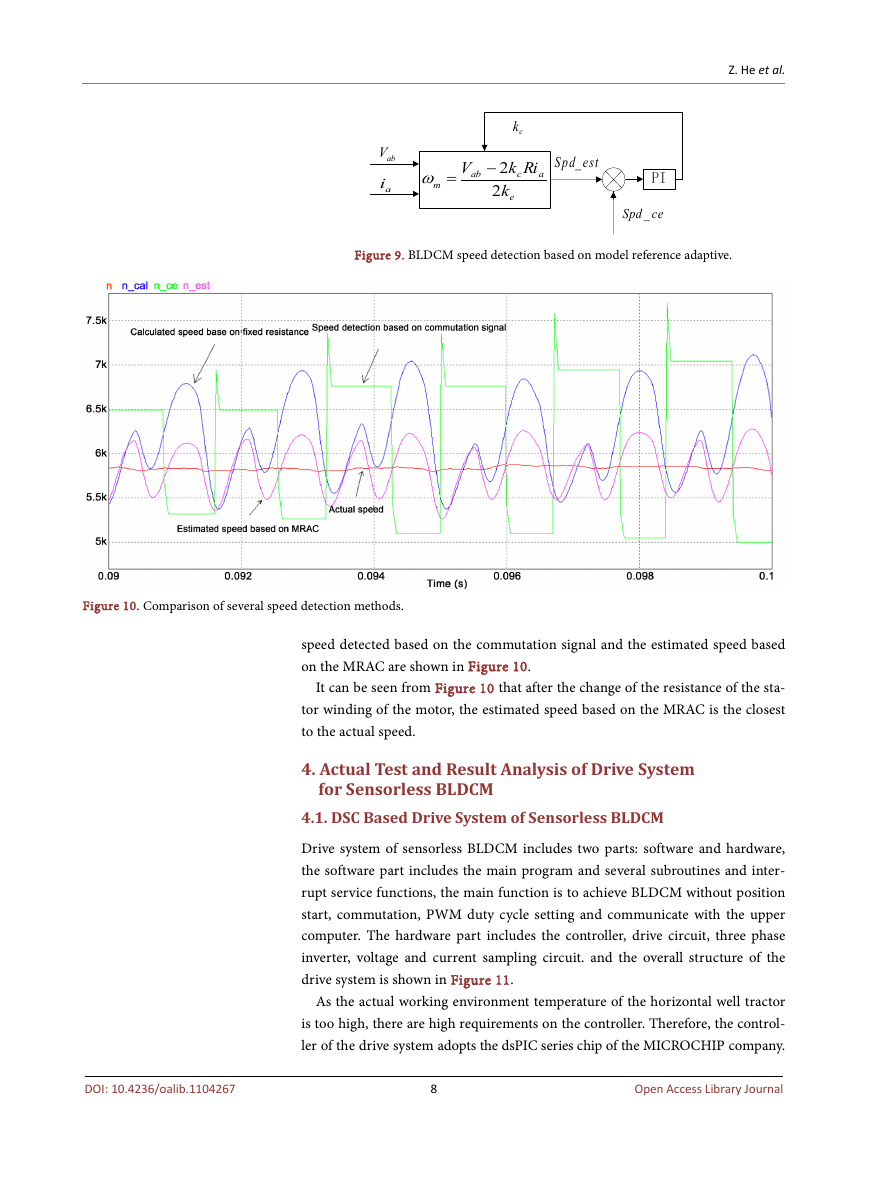








 2023年江西萍乡中考道德与法治真题及答案.doc
2023年江西萍乡中考道德与法治真题及答案.doc 2012年重庆南川中考生物真题及答案.doc
2012年重庆南川中考生物真题及答案.doc 2013年江西师范大学地理学综合及文艺理论基础考研真题.doc
2013年江西师范大学地理学综合及文艺理论基础考研真题.doc 2020年四川甘孜小升初语文真题及答案I卷.doc
2020年四川甘孜小升初语文真题及答案I卷.doc 2020年注册岩土工程师专业基础考试真题及答案.doc
2020年注册岩土工程师专业基础考试真题及答案.doc 2023-2024学年福建省厦门市九年级上学期数学月考试题及答案.doc
2023-2024学年福建省厦门市九年级上学期数学月考试题及答案.doc 2021-2022学年辽宁省沈阳市大东区九年级上学期语文期末试题及答案.doc
2021-2022学年辽宁省沈阳市大东区九年级上学期语文期末试题及答案.doc 2022-2023学年北京东城区初三第一学期物理期末试卷及答案.doc
2022-2023学年北京东城区初三第一学期物理期末试卷及答案.doc 2018上半年江西教师资格初中地理学科知识与教学能力真题及答案.doc
2018上半年江西教师资格初中地理学科知识与教学能力真题及答案.doc 2012年河北国家公务员申论考试真题及答案-省级.doc
2012年河北国家公务员申论考试真题及答案-省级.doc 2020-2021学年江苏省扬州市江都区邵樊片九年级上学期数学第一次质量检测试题及答案.doc
2020-2021学年江苏省扬州市江都区邵樊片九年级上学期数学第一次质量检测试题及答案.doc 2022下半年黑龙江教师资格证中学综合素质真题及答案.doc
2022下半年黑龙江教师资格证中学综合素质真题及答案.doc